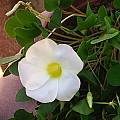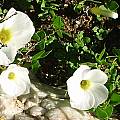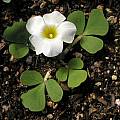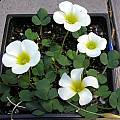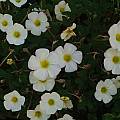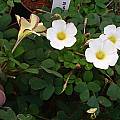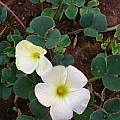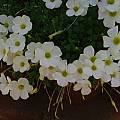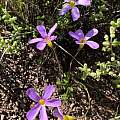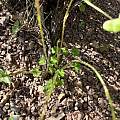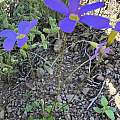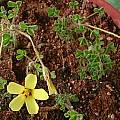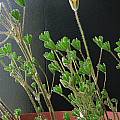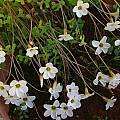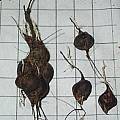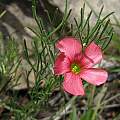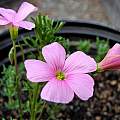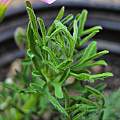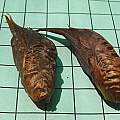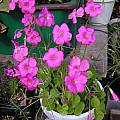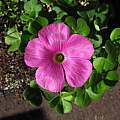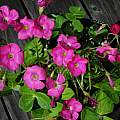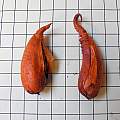There are more than 200 species of Oxalis in South Africa and 270 varieties and probably many new species as well. The only handbook on the Southern African species, by Salter, is almost sixty years old and out of print so there are many challenges in identifying them. Cape Plants, a conspectus of the Cape flora of South Africa by Peter Goldblatt and John Manning lists 118 in the Cape Floral Kingdom but there is only a brief botanical description, location sometimes with habitat information, and time of bloom in this book.
South African species A-B are found on this wiki page.
Oxalis index - Miscellaneous Oxalis - Oxalis flava - Oxalis hirta - Oxalis obtusa - Oxalis pes-caprae - Oxalis purpurea - South African oxalis c - South African oxalis d-e - South African oxalis f-g - South African oxalis h-k - South African oxalis l-m - South African oxalis n-o - South African oxalis p - South African oxalis r-s - South African oxalis t-z - South American oxalis
Oxalis adenodes Sond. is one of my favourites. This species is quite variable in size and degree of hairiness, and has a large geographic distribution, mostly in Namaqualand, but also extending into Bushmanland. The second photo was taken near Kamieskroon. Photos by Christiaan van Schalkwyk.
Oxalis ambigua Jacq. is described as having 3 hairy leaflets and white, yellow, or cream flowers with a yellow tube and blooming in winter. Height: 4-12 cm. The species is found in rocky hills of Namaqualand and on the Gifberg in the succulent Karoo biome. The photos below by Mary Sue Ittner are of two Michael Vassar collections. The first, Oxalis ambigua MV4967 was collected 19.2 kms south of Calvinia. The collection data noted large copper salmon flowers held above the leaves. My plants rarely flower, but when they have, the flowers were white. The second, Oxalis ambigua MV5532 was collected by Michael Vassar 123 km south of Pofadder. It has ivory flowers with a yellow center, nice bright green leaves, and blooms for me in the fall and does not seem happy with excessive winter rain.
The first two photos below are from plants west of Kamieskroon, the third from South of Kamieskroon. Both are hirsute forms, but note the stem in the second photo. Not all plants or colonies are caulescent, and the acaulescent forms are more often seen. The leaflets of the western plants are much narrower than those South of Kamieskroon. Photos by Christiaan van Schalkwyk.
Oxalis annae F.Bolus is a very variable species found over a large geographical area; several colour forms have been recorded. This one is from west of Garies and is villose, white flowered, and floriferous. Height: 2-6 cm. Photo by Christiaan van Schalkwyk.
Oxalis anomala T.M.Salter is a fairly large, stemless plant. The peduncles are one or two flowered, and are much longer than the leaves. The flowers are rosy-violet in colour. Plants cultivated under this name are most commonly Oxalis virginea. Photos from iNaturalist were taken by katrivier in May near Ladismith in the Little Karoo and shared under a CC BY-NC license
Oxalis argillacea F.Bolus is quite a hairy species with only the corolla glabrous. The red marks in the flower are not distinctive, and apparently rare. This species can change dramatically in size from year to year, depending on weather conditions. It is found in the Vanrhynsdorp and Calvinia districts. Height: 15-30 cm. Photos by Christiaan van Schalkwyk.
Oxalis attaquana T.M.Salter has long shiny hairs (not seen clearly in the picture) and fairly small white flowers borne in masses. The literature states that it is an erect plant, but I guess my overfeeding and watering causes it to topple over. Height: 30-45 cm. The shape of the leaves is quite unique in shape (obreniform) and the leaves are slightly succulent. I have received a plant labelled as MV 4621B Oxalis imbricata var. violacea which I believe is a misidentification. It is identical to this plant, except for its pinkish flowers. Photos by Christiaan van Schalkwyk, the bulbs on a 1 cm square grid.
Oxalis bifurca G.Lodd. is distributed in coastal grassland in the Eastern Cape. There are two varieties: Oxalis bifurca Lodd. var. angustiloba Sond. and Oxalis bifurca Lodd. var. bifurca. It has scattered leaves that are divided into three deeply forked leaflets that are silky below and hairless above and solitary white or rosy purple flowers with a yellow tube. Height range: 15-30 cm. Flowering is listed in the Eastern Cape field guide as occurring from August to October, but Salter lists this species as flowering in summer (into fall), January to April. The first photo from Cameron McMaster was taken in the Eastern Cape mid January 2008. The next three photos were taken by Mary Sue Ittner of plants received from the BX showing flowers, leaves, and bulbs on a 1 cm grid. It was flowering for her in the northern hemisphere September-October 2014. Ernie DeMarie, the source of the bulbs in Mary Sue's photos, reports that his plants start into growth late summer. From a distance the top of the leaves look hairless, but with a lens and because the bottom of the leaves and margins of the leaves have long hairs the impression of the leaves is not that they are hairless as can be seen in the leaf photo.
Oxalis bowiei Herb. is a fall blooming species from the Eastern Cape of South Africa with more than one large pink flower per stalk and leathery trifoliolate suborbicular-obcordate leaves. Height: to 25 cm. Even though it is from the Eastern Cape, in cultivation in northern California, it behaves as a winter grower. Photo 1 was taken by Bob Rutemoeller, photo 2 was taken by Bill Dijk, 3 was taken by Nhu Nguyen and photos 4-5 were taken by Mary Sue Ittner. Photo 5 shows the large bulbs on a 1 cm grid.
Oxalis index - Miscellaneous Oxalis - Oxalis flava - Oxalis hirta - Oxalis obtusa - Oxalis pes-caprae - Oxalis purpurea - South African oxalis c - South African oxalis d-e - South African oxalis f-g - South African oxalis h-k - South African oxalis l-m - South African oxalis n-o - South African oxalis p - South African oxalis r-s - South African oxalis t-z - South American oxalis
